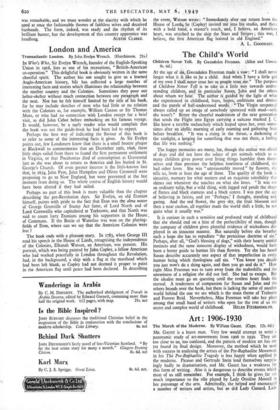Art : 1906-1930
The March of the Moderns. By William Gaunt. (Cape. 12s. 60
Mit. GAUNT is a brave man. Very few would attempt to write a panoramic study of art-movements from 1906 to 1930. They are too close to us, too confused, and the pattern of modem art has not yet found its final design. Moreover, the method which he used with success in analysing the artists of the Pre-Raphaelite Movement in his The Pre-Raphaelite Tragedy is less happy when applied to the moderns. Picasso and Gertrude Stein lend themselves surpris- ingly badly to dramatisation, and Mr. Gaunt has a weakness for this form of writing. Also it is dangerous to describe events which most of us still remember. For example I think he gives far too much importance to the role played by lady Ottoline Morrell in her patronage of the arts. Admittedly, she helped and encouraged a number of writers and artists, but so did Lady Cunard, Lady
Lavery and Lady Wimborne, whose names do not even appear on these pages. More serious still, Mr. Gaunt makes no reference to Sir Edward Marsh, and yet it was Sir Edward who edited the Georgian Poetry series and who, as a collector, has done more than any other private individual to .foster the best talent in modern English painting.
But The March of the Moderns has its virtues. The opening chapters devoted to the strange histories of Cezanne, Gauguin and Van Gogh are well-done and easily the best in the book. In these Mr. Gaunt's vivid and often journalistic style does bring the char- acters of these fathers of modern painting to life, and he has used passages from their journals and letters with telling effect. Yet how orderly these rebels against tradition appear when contrasted with the frenzied revolutions advocated by the young Picasso, Max Jacob, and the now-forgotten Marinetti ! Today we are apt to forget the public stir caused by the advent of Cubism and the Futurists. When one looks back, however, there is a sinister sound about the Futurist doctrines proclaimed by Marinetti. In the words of Mr. Gaunt : " The reasoning, at least, was very serious. Futurism must be
total—a way of life—a state of mind. The dominance of art—or
the aloof position it had got into—must come to an end. Each art must be moulded anew, made to serve the purpose and exalt the
glory of a warrior race, be swept into the current of modern life.
Imperatives thundered on in quick succession. The abrupt orders were given to literature, painting, music. No mention was made of religion. That Futurism consisted in the worship of war and its engines was assumed. It was a ' rejuvenation through barbarism.'"
This was taking place between the years 1910 and 1914, yet these doctrines might have been announced by Mussolini. Indeed, reading Mr. Gaunt's account of the rise of Cubism and Futurism, we now see the dangers of such destructive artistic doctrines. This anarchy in modern art was preparing the way for the destruction of society, and The March of the Moderns reads like a horrible cautionary tale. Several significant facts emerge from Mr. Gaunt's ambitious study of the growth of modern art. The men who directed the revolutionary movements in Paris were mostly foreigners. Picasso was a Spaniard ; Marinetti an Italian ; Gertrude Stein an American ; and both Max Jacob and Guillaume Apollinaire were men without a country, being Jews—Apollinaire a Polish one. French artists like Matisse and Georges Braque were much more conservative by nature, although they subscribed to the new movements. The English avant-garde was also much milder in its revolutionary ideas.
It is true that Wyndham Lewis and C. R. W. Nevinson organised a dinner of welcome at the Florence Restaurant to Marinetti in 1913, and Wyndham Lewis launched a new movement, Vorticism, in his review, Mast. But the majority of young English painters and writers and poets gravitated round the art-critic Roger Fry and the Poetry Bookshop run by Harold Munro. Roger Fry's theories about art were diametrically opposed to those of Wyndham Lewis, and his Omega workshop, where painters like Vanessa Bell and Duncan Grant worked, attempted to create a modern school of art, furniture and fabrics rather on the lines of the one started earlier by William Morris.
The last chapters of this ambitious book are devoted to the art movements which followed the First World War. Confusion of ideas still reigns, but already the tempo is changing. Gone is the happy optimism of the young Cubists and Futurists. Instead we have The Waste Land, which sums up the agony of a whole genera- tion. Intensely readable, despite its omissions, this book deserves to be studied by all interested in modern art.
DEREK PATMORE.







































 Previous page
Previous page